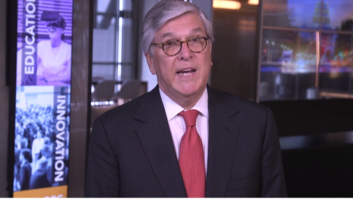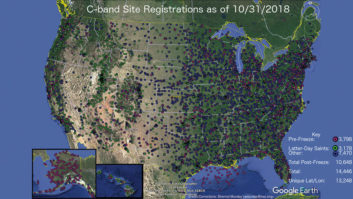Photos
(click thumbnail)I found a Compaq R1500XR UPS on eBay, without batteries or faceplate. It was inexpensive. This is only one of many models that will suffice.
(click thumbnail)This is what it looks like with the cover removed. At the top is the empty battery compartment.
(click thumbnail)I was able to find a 48V switching supply that was perfectly matched to the UPS; they both have 48V/30A ratings. I jumpered a few pins on the connector, shown, so that it didn’t need to be plugged into its shelf as in normal operation. The large connector pins are the floating 48VDC output.
(click thumbnail)Other than jumpering the connector block and modifying the input voltage sense circuit to compensate for the peak detecting ‘voltage good’ detector, the supply was perfect as-is. Below, the supply is mounted in the empty battery area of the Compaq UPS. I punched a hole and put a fan guard on the side to provide ventilation for the switcher. Although there are holes on top, it’s possible to stack the assemblies for extra power, and I wanted to make sure there was air for the fans to move.
(click thumbnail)The final system! The system supplies 115VAC at 1.3kW (1500kVA) at a weight penalty of less than 40 pounds, and without any drain on the vehicle’s low-voltage electrical system.
(click thumbnail)But where is it?
(click thumbnail)The Prius trunk floorboard can be removed to reveal a space large enough for the system and then some. Of course you can put it wherever you like. For permanent use it should be mounted securely, with the controls accessible, the air port clear and room to connect to the AC sockets. For casual use, just make sure it doesn’t shift while driving. While it’s only 38 pounds, it’s still 38 pounds. In Radio World’s March 29 issue, Paul Kaminski offered valuable tips on choosing a station vehicle. I was pleased to see that hybrids were among the suggestions, albeit with the caveat of long delivery times.
The advantages of using a hybrid such as the Toyota Prius or Highlander as a station vehicle were only sketched in his article, and I thought it would valuable to expand on one that wasn’t mentioned.
As you probably know, a hybrid makes use of a robust battery and electrical system to augment the gasoline engine. You may have even read about “plug-in” hybrids, the so-far-experimental vehicles that allow you to charge them at night from a wall outlet, and approach 100 miles per gallon during daily usage!
Of greater interest to a radio station, both for remote promotions and field engineering work, is that the hybrid electrical system can also be used to deliver electric power, in substantial amounts, wherever you take the car.
Your own resource
I purchased a Prius after I read the specifications and realized that it could literally supply enough power to run my house in emergencies.
My personal project over the past year was to implement this, and a project Web site, www.PriUPS.com, abundantly details this.
The PriUPS project uses a large (12kVA) UPS in my basement, and when there’s a utility power failure I connect the Prius to it with welding cable. For portable usage, you are much more likely to simply need a standard 15Amp AC outlet to run the PA, power tools, illuminated signage, station uplinks, etc.
Wouldn’t it be nice to be able to have your own resource, without either relying on the venue or needing a small gasoline generator that must be located in the next county to make the noise bearable?
If your station vehicle is a hybrid, here’s how to provide your own power. It’s easy and cheap!
The first step is to think of the car as having a big, always charged battery. In a normal 12V car, the engine runs continuously and turns the alternator to keep the battery charged. Horribly inefficient, but the 12V battery is always charged and you can plug an inverter in and get a few hundred watts before blowing a fuse. With the hybrid, the 12V battery is now 220V!
The Prius, for example, can deliver 3 kW continuously, and the internal combustion engine will only start up, typically on a 10-20 percent duty cycle, when needed to keep the battery charged. Want to run a big PA or to provide for motor starting surges? Although the 3 kW average is dictated by thermal considerations, you can easily take 50-100A from the battery, i.e., 10-20kW for peaks. Once you have access to the hybrid battery, everything is possible.
Convert
“Well, great,” you say, “except my equipment runs on 115VAC. not 220VDC.” Don’t be shocked but I might have actually considered this. It is, after all the key to the whole project. Consider the following
* Converting 230VAC to 24VDC or to 48VDC is the routine job of inexpensive and efficient switching supplies, such as those used in computer servers and telephone company “rectifier shelves,” where they are used to keep telco batteries charged. In order to do this, they first must rectify the 230VAC to 230VDC to run the downconverter. By starting out with 220VDC, we’re eliminating the middleman! In other words, many of these supplies will run on DC with little or no modification.
* Converting 24VDC or 48VDC to 115VAC is the routine job of inexpensive and efficient computer UPS units. Units in the 1 to 2 kW class typically have 24V or 48V battery packs and can cost only a few hundred dollars even if bought new.
Both as a proof of concept and as a convenient 115VAC outlet to have when needed, I picked up some hardware on eBay. The photos accompanying this article show my conversion of an HP/Compaq R1500XR, rated at 1500VA/1.3kW, to a UPS running from the Prius “traction battery.” There is no need to imitate my system; you have many choices of usable hardware. Here’s what you should look for in the UPS:
1. A power rating around 1 to 2 kW. These will normally have either 24V or 48V battery packs. Make sure you check before you buy it so you can match it to the switcher.
2. “Cold start capability.” You want to be able to start it from battery only, rather than having to plug it to AC power first. Most units have this feature.
3. A way to disable the warning beeper. Since it will be running on “battery,” it will always want to beep. As a last resort, you can simply find and disconnect the beeper.
4. If you can find a UPS with an external battery connector, it may be easier to attach to the switcher, and it will also tell you that the UPS is robust enough to run for a long period.
5. Hint: You can frequently find a UPS without batteries for a fraction of the cost of one with good batteries. Or you might even ask the seller to just discard the batteries before shipping; this will make getting it to you much cheaper.
The downconverting switchers usually are sold in large quantities and even new ones are inexpensive, typically a few hundred dollars. “New” is therefore an alternative it you’re not keen on eBay. Here’s what you should look for in the switcher
1. 24V/40A or 48V/20A or greater output. You can easily connect them in series if necessary, and you can usually connect them in parallel as well since many have provision for output power sharing. The total power should be commensurate with the requirements of the UPS.
2. 240VAC input. Most will work at this voltage, some will only work at this voltage. Try to check the manufacturer’s specifications to confirm that they have power factor correction and a full wave bridge rectifier at the input.
3. Getting the right form factor so the supply can be inserted in the space vacated by the UPS batteries is a benefit.
4. Bonus: It’s likely that a 230V unit will work with much higher battery voltages, such as those of the Toyota Highlander hybrid SUV, since they have to rectify high line (240V) plus a safety factor (1.2?) plus the RMS-to-Peak conversion (1.414), or about 400VDC.
The photos show the switcher and UPS combined in a single unit and ready to roll. Selecting an “environmentally correct” hybrid vehicle for your station can be a boon for your corporate image. The practical benefits of great mileage and abundant power may tip the scale when making your decision. The author is founder and chairman of Eventide Inc. Write to him at [email protected]. Got a handy tip of your own? Tell us at [email protected].



















